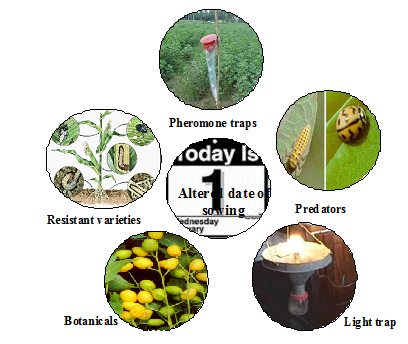தோட்டக்கலைப் பயிர்களின் பூச்சி மேலாண்மை
Pests of Tomato
Helicoverpa armigera
-
Collect and destroy the infected fruits and grown up larvae.
-
Grow less susceptible genotypes Rupali, Roma, Pusa red plum.
-
Grow simultaneously 40 days old American tall marigold and 25 days old tomato
-
seedling at 1:10 rows to attract Helicoverpa adults for egg laying.
-
Setup pheromone trap with Helilure at 15/ha and change the lure once in 15 days.
-
Spray HaNPV at 500 LE/ha along with cotton seed oil 300 g/ha to kill larvae.
-
Release Chrysoperla carnea at weekly interval at 50,000 eggs or grubs / ha from 30
-
days after planting.
-
Six releases of T. chilonis @ 50,000/ha per week coinciding with flowering time and
-
based on ETL.
-
Spray B. thuringiensis 2 g/lit
-
Do not spray insecticides after maturity of fruits.
-
Encourage activity of parasitoid Eucelatoria bryani, Campoletes, Chelonus etc.,
2. Leaf miner
3. Spodoptera litura
-
Plough the soil to expose and kill the pupae.
-
Grow astor along border, irrigation channel as indicator or trap crop.
-
Flood the field to drive out hibernating larvae.
-
Set up light trap at 1/ha or pheromone trap at 15/ha with pheroclin SL lure.
-
Destroy egg masses and grown up larvae.
-
Spray SNPV at 250 LE along with teepol 1ml/lit in evening hrs.
4. Whitefly
-
Uproot and destroy the diseased leaf curl plants
-
Remove alternate weed hosts.
-
Use irrigation judiciously.
-
Use yellow sticky trap to attract and bill insects.
-
Spray FORS 2% / neem oil 0.5% along with teepal 1 ml/lit.
-
Encourage activity of parasitoids Eretmocerus mesii and predator coccinellids,
-
Brumus and Chrysoperla.
5. Thrips
-
Collect and destroy the damaged leaves and twigs and uproot the diseased plants.
-
Use yellow sticky traps at 15/ha to attract and kill insects.
-
Release first instar larvae of Chrysoperla carnea @ 10,000/ha and encourage
-
coccinellid predator.
|

